- INDIAN HISTORY - An Introduction
- Ashoka the Great
- Aryabhata
- Akbar the Great
- Mahatma Gandhi
- Nehru
- The World's Oldest Civilization: Off the Coast of North Western India - Ancient City Called Dwarka - 9,500 Years Ago Video Series
- Debunking the Myth of the Aryan Invasion Video Series
INDIAN HISTORY
The history of India can be divided into the following sections:
(1) The Early Pre-History and Indus Civilization
(7) The Mughals
(8) Gupta Empire (under preparation)
(9) Sultanates of Delhi (under preparation)
(10) Colonial India and the freedom struggle (under preparation)
1) THE EARLY PRE-HISTORY
Recent archaeological finds in India has pushed back the origins of late Stone Age settlements in India to as early as the 8th Millennia B.C. These include the familiar late Stone Age hunter-gatherer as well as the later agriculturists’ settlements. Evidence of domestication of cattle, buffalo, sheep and goats and use of pottery and copper and iron objects has also been found in these sites. And these sites have been widespread in many parts of the subcontinent, from Baluchistan in the west to Bengal in the east and from North-West Frontier Province in the north to Sri Lanka in the south.
A site found at Maraiyur in the eastern foothills of Kerala and dating between the 8th and 2nd Millennia BC revealed paintings, drawings and engravings on the interior of a rock wall 39ft high and 31 ft wide. At Langhnaj in Gujarat was a sand dune that showed evidence of long human occupation dating from the 6th to the 3rd Millennia. Similar sites in Bagor near Udaipur in Rajasthan and at Langhnaj, copper objects and pottery were found. The first settlements in Baluchistan resemble the agricultural societies of Euphrates-Tigris and the Nile basin. Radiocarbon dating of these settlements put them at around 3,500 BC.
These settlements and sites such as Mundigak in Southeastern Afghanistan and others such as from the Quetta valley (Kili Ghul Mohammad) appear to be semi nomadic pastoralism with only minimal cultivation. While some degree of domestication and use of copper and clay pottery were present, permanent structures were not constructed; city dwelling would be sometime in the future. This middle period of development proceeded until around 2500 BC, after which the fully developed city-dwelling civilizations emerged. As a consequence of the appreciation of the agricultural potential of the Indus floodplains, many pre-Indus valley civilizations developed. Examples of these are found at Amri, at Kot Diji just north of Amri and Kali Banga, the latter on the banks of Saraswati River (present day Ghaggar).
Evidence of similar settlements is to be found in many other parts of India. In the Vale of Kashmir, at Burzahoun near Srinagar a settlement with radiocarbon dating at around 2375 BC, bone and antler harpoons and needles and ground-stone axes were used by the settlers. Other sites were found in widely separated locations such as in Karnataka, Andhra Pradesh as well as in Assam and the central India. All these populations used stone axes and pottery of different grades. For example, in Assam cord-impressed pottery was found whereas burnished gray pottery was the style in Kashmir and Karnataka.
B): THE INDUS VALLEY CIVILIZATION AND ITS CONTEMPORARIES:
“ India confronts Egypt and Babylonia by the 3rd Millennia with a thoroughly individual and independent civilization of her own, technically the peer of the rest. And plainly it is deeply rooted in Indian soil. The Indus civilization represents a very perfect adjustment of human life to a specific environment. And it has endured; it is already specifically Indian and forms the basis of modern Indian culture”. V. Gordon Childes’ words were in tribute to the city dwellers of Mohenjo-Daro and Harappa. Recent archaeological discoveries put Indian history into much further back in time, although the formal urban civilizations flourished between 3000 and 2300 BC.
The development of the Indus Valley civilization as exemplified by Mohenjo-Daro and Harappa is a natural sequence of events considering the fertility of the alluvial soil the river basin offered. It is also considered to be a natural extension of the earlier, semi-nomadic civilizations of Baluchistan and elsewhere in India. Much of the evidence excavated at these sites point to an indigenous Indian civilization rather than an imported one, for example from Mesopotamia. However, ample evidence exists for contacts between these and other cultures including the Persian, Mesopotamian as well as the far east, the latter represented by the Chinese.
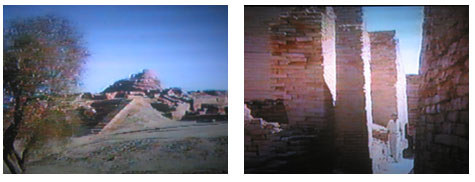
IMAGES FROM ARCHAEOLOGICAL SITES IN MOHENJO-DARO
Evidence for settlement in the floodplains of the Indus has been dated back to the beginning of the 3rd Millennium. The site evidently offered an excellent opportunity for agriculture. Rapidly, these settlements expanded and developed into discreet societies, spreading north and east and by the middle of the millennium, reached as far as Kali Banga. Other sites included Chanhu-daro, Kot Diji and Amri. In most instances the transformation seems to have been peaceful but at least in the latter two sites there is suggestion of violent upheaval, as evidenced by thick layers of ash.
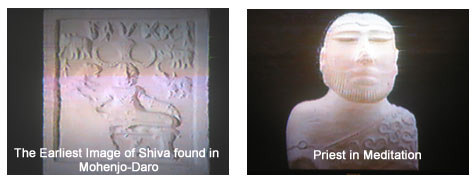
Even this early certain practices that can be considered distinctly Indian appeared, some of which already point to roots of Hinduism. An example of the latter is found in the form a seated yogi and objects reminiscent of Shiva linga (a phallic representation of the Lord Shiva). Bullock carts with framed canopy and the shape of boats are almost unchanged to this date. Women wore elaborate ornaments and bangles, another distinctive Indian trait. These people built great granaries and citadels, the latter bearing similarities with Mesopotamian structures. Their greatest achievement, however, was the exquisitely planned cities with roads and streets laid out in a grid pattern. The houses were made of burnt brick; they had living quarters built around a central courtyard and many also had sewage system for removal of waste into municipal sewage through drainage chutes. Communal baths were also a common feature and these predate Roman baths by at least a millennium. Most the houses had private wells and at least one bathroom.
Agriculture and domestication: Animals have been regularly domesticated by the inhabitants of all the Indus Valley settlements. Wheat, barley and rice were among the cereals cultivated by these peoples. Other crops include dates, melon and several legumes. The cultivation of cotton was of course, of importance for textile manufacture. Buffalos, cattle, camel, pigs, cats, dogs, sheep, goats and fowl were all domesticated by these peoples.
Tools and implements: Copper and bronze were used for making tools and implements. Knives, spears, arrows, razors and chisels were all used by all the Indus Valley civilizations. Also in evidence is use of gold, silver and lead. Another specialty of the civilization was the use of pottery. An enduring industry and one that India is famous for was already in evidence in Indus valley centers; it is the textile industry using cotton grown locally.
Trade: Evidence for trade between Indus valley inhabitants and various other regions of India as well as the Persian Gulf states including Mesopotamia include the Harappa seals (used to seal bundles of merchandise), as well as items unique to certain regions of both India and the other Asian countries with trade links with the Harappan cultures. Some examples of the latter are turquoise and alabaster (both from Iran), jade (central Asia), gold (north Karnataka), copper (from Rajasthan as well as Baluchistan and further west; amethyst (Maharashtra) and fuchsite (from Karnataka). Also, official inscriptions in Mesopotamia mention Meluhha (ancient Akkadian name for the Indus region).
Language, Religion: Inscriptions recovered from the Indus Valley have no resemblance to Indo-European family (Sanskrit, Latin etc) or the middle-eastern languages. Although it seems to be written from right to left, the closest resemblance is thought to be with the Dravidian languages (Tamil, Telugu, Kannada , Malayalam and Tulu). Final word on the deciphering of the recovered inscriptions is awaited. Religious practices seem to indicate distinctly Indian attributes. A belief in a Great God (presumably Lord Shiva) and a Great Mother God (Shiva’s spouse, Parvati) and the origins of yogi in meditative posture, the swastika are clearly Indian. Some signs of influence from Mesopotamia are also evident. Cemeteries excavated at Harappa, Lothal and Kali Banga indicate a clear belief in afterlife.
Art: Stone sculpture, which are rare finds, vary greatly in quality. Many are of poor artistic quality but some are excellent. Cast-bronze are generally of better quality and exemplifies technical excellence. Of most interest are probably toys; examples are monkeys pierced to climb a string and cattle that nod their heads!
The fall of the Harappan Culture is thought to have occurred after 1750 BC. The speculated causes of their decline are a catastrophic flood or a major change in the course of the Indus river that led to the dying out of the fertile area and one even more plausible cause of the population growth outstripping the food supply and to deforestation.
SOURCES:
Encyclopedia Britannica
The True Path, by Roy Mathews, Perseus Publishing
http://www.san.beck.org/EC7-Vedas.html
POST HARAPPAN PERIOD (1200 BCE TO 500 CE)
The material that helped me write this segment of Indian history is derived from both archaeological findings and from the writings from that period. A careful scrutiny of such evidence all but convinced me that, of all segments of Indian history, the period that helped shape the Indian persona, its character, it’s standing in world history and philosophy is this post-Indus valley civilization era. While no dynasty or major settlements (in the manner of Indus valley civilization) dominated this period, one witnesses the laying down of the foundation of and flowering of Hinduism, Jainism and Buddhism to such extent that these teachings remain substantially unchanged almost 3 millennia later. The literary gems that were composed during this period remain masterpieces of philosophical and theological thoughts.
This process began with the composition of the “Vedas” but flowered into the epics “Ramayana” and “Mahabharata”. An off-shoot of the latter and of great significance to Hindu way of life is the “Bhagavad-Gita”. Pure philosophical discourses without any references to historical events are the Upanishads. In contrast, the “Puranas” dwell upon dynasties that date back to the 4th Millennia BC. After the above treatises helped define Hinduism, two more major religions took root in India. Both also originated about the same period (6th Century BC). The first, Jainism, a strict ascetic religion remained confined to India but Buddhism not only spread all over India and Sri Lanka but also to China, Japan, Korea, Viet Nam and most countries of the South East.
Instead of dividing this period of Indian history into time segments, I will describe the above major literary and philosophical works and the religious teachings. They will at once help us delve into the Indian psyche and the historical time lines. Thus, the following major subsections will be the platform; however, when an important personality, event or dynasty demands our attention, we will take a suitable detour:
1) Roots of Hinduism
2) Vedic Hinduism
3) Ramayana, Mahabharata and Bhagavad-Gita
4) Jainism and Buddhism
5) Pre-Mauryan states
1) ROOTS OF HINDUISM:
I have already indicated in the section on Indus Valley civilization that certain hints of distinctly Indian belief systems had already developed there. In the 3rd Millennia BC, these village-dwelling people left terra-cota figurines of women there and these have been believed to be some fertility deity. Combined with figures of bull, scholars see a connection between this civilization and the Mediterranean area. The “Great Bath”, a structure found in the central part of the Citadel in Mohenjo-Daro is thought to have been used for ritual bathing. Measuring 897Sq ft, the bath was constructed of fine bricks, approximately 8ft lower than the surrounding pavement. Flights of steps led to the level of the bath and an adjacent well supplied the water for the bath. All modern Hindu temples have large bathing ponds with similar construction and are obvious descendants of this “Great Bath”.
While the scriptures left by these peoples have not been deciphered and therefore appropriate interpretation is difficult, small conical objects thought to be phallic emblems definitely show a link to later day Hinduism and the deity Lord Shiva. Another reminder of this tradition are the ‘ghats’ (the bathing steps on river banks) which are found in most Hindu temples of today. Belief in “sacred animals” and trees also make a link between the Harappan civilization and Hinduism.
2) VEDIC HINDUISM (2nd Millennium to 7th century BC):
THE VEDAS:
“Creative energy was there with energy and action,
But who really knows where this creation came from?
For the gods came after the world’s creation.
Who could know the source of this creation and how it was produced?
The one seeing it in the highest heaven only knows,
Or may be it does not” from The Rig Veda.
I have included the sacred scripture of Vedas along with the Upanishads as they deal with the same general theme, were composed in roughly the same time period and because, collectively, they define the Hindu belief systems. The Vedas were composed around 1400 BC, the Upanishads between 1100 and 700 BC. Most scholars regard the Vedas as the most important (Veda= “Books of Knowledge”), of which there are four main Texts: “Rig Veda” (the oldest, the wisdom of the verses), the “Sama Veda” (wisdom of the Chants) the “Yajur Veda” (wisdom of the sacrificial formulas) and the “Atharva Veda” (wisdom of the Atharva Priests).
Composed in the 2nd Millennia BC and organized into 10 books or Mandalas, much of Rig Veda is devoted to description of the influx of the fair skinned “Aryans” (“the noble ones”) into India. There they discover, already flourishing, city dwellers of the Harappan culture. With their superior military weaponry the “Aryans” subdued and then enslaved the dark skinned “dasyus” (the indigenous inhabitants of the Indus valley). Thus, many of the hymns in the Rig Veda are devoted to glorifying this conquest and the justification of it.
The Rig Veda is also concerned with rituals to pacify the many Gods that Hindus already believed in. These were Indra (the foremost god of the Vedic pantheon), Varuna (the guardian of the cosmic order), Agni (the sacrificial fire) and Surya (the sun). The rites of marriage and disposal of the dead were described in the Rig Veda and has been followed in later Hinduism. Some special rituals in Rig Veda are contained in the “Soma sacrifice”, using a hallucinogenic beverage. In this practice, animal sacrifice, usually of goats was made in honor of the hallucinogen in Soma juice. During the sacrifice the juice was also poured on the offerings and toasted to different gods. During the Rig Veda period the Brahmins (the priests and teachers of the scriptures) emerged as the specialists in such rituals and one can see the beginning of the caste system in Hinduism.
Sama Veda is a compilation of melodies and music for the chants of Rig Veda. The contents of Sama Veda represent the origin of the Indian music as well as of the musical notes, which later became the basis of the Western musical notes.
Yajur Veda dates to the 10th Century BC, by which time the priestly class and the ruling Kshatriyas accumulated wealth and power in their hands and the structure of the Hindu class system was in place. This Veda text is divided into two “Samhitas” (collections), the White and the Black, the latter being somewhat obscure. The text deals with the construction of the altars for and performance of the various rituals and animal sacrifices. The highest form of sacrifice was the “Sarvamedha” in which the sacrificer paid all his possessions as fee at the end of the ceremony.
Atharva Veda, the last of the Vedas compilations, deals primarily with magical spells and incantations. Positive spells included those conducted for successful childbirth, romance, virility and for healing many ailments. The negative spells were for attempting to cause disease or other harm to the enemies. After the period of Atharva Veda, all sacrificial performance required four priests, each an expert in the four Veda Samhitas. Atharva Veda has other positive manifestations in that philosophical and abstract thinking started to appear and seems to be the forerunners of the Upanishads.
UPANISHADS:
“Upanishad” means “those who sit near” implying that this learning was from listening closely to a teacher. Composed between 1100 and 700 BC, the abstract, esoteric, highly introspective philosophical renditions do not speak of sacrifices or conducting rituals (that the Vedas were concerned with) but seem to seek answers to unknowable and unanswerable questions regarding the undying soul and its connection with God the “Supreme Soul”. Although there are at least one hundred Upanishads but only 14 contain scriptural material. These are the Aitareya, Brhadaranyaka, Chandogya, Isavasya, Katha, Kaivalya, Kausitaki, Kena, Maitri, Mandukya, Mundaka, Prasna, Svetasvatara and Taittiriya Upanishads.
Even before the Upanishads Hinduism, with its caste system was well in place. The Brahmin caste, with its almost exclusive knowledge of the Vedas was the priests and teachers. The Kshatriya were the ruling caste, vaisyas were the farmers and merchants and the sudras the working class. Justification for this strict division of labor can be found in the following hymn from the Rig Veda:
“The Brahmin was His mouth,
Of both His arms was the Rajanya made.
His thighs became the Vaisya,
From His feet the Sudra was produced”.
The Upanishads attempt to make the connection to the Supreme Soul, the Brahma though meditation and numerous chants were described. A very limited collection of these is presented below:
“He the Supreme Soul, who dwells in all human beings, who controls all beings, yet, whom the beings do not know, is the inner ruler, the imperishable”.
“God dwells in the heart, where, like the spokes of a wheel on its limb, the arteries come from all over the body. Worship Him by repeating the word OM. By doing so you will cross over and beyond darkness”.
“He is the knower of everything. His glory is manifest in the universe He created. He shines in the hearts of people. He is the One who has endowed us with a mind and has given us life. Wise people recognize Him in their own heart and receive His bliss by finding the glorious eternal within”.
“Sinless sages see the glorious Lord in their own hearts-the Lord who is attainable through truthfulness, meditation, wisdom and continuous self-discipline”
The Upanishads repeatedly dwell on the subject of the indestructible nature of the soul.
“At death the voice goes into the mind, the mind into the breath, the breath into heat and heat into the highest divinity, the finest essence of truth and soul”
“Truly, indeed, when the living soul leaves it,
This body dies; the living soul does not die.
That which is the subtle essence
This whole world has for its soul.
That is reality (truth). That is the soul.
That you are, Svetaketu
“Speech is to be valued, because it makes known right and wrong,
True and false, good and bad, pleasant and unpleasant.
Mind is revered, because it enables one to do sacred work.
Will is valued, because heaven and earth and all things were
Formed by being willed.
Thought is important, because it is better not to be thoughtless.
Meditation is revered, because one attains greatness by meditation.
Understanding is valued, because by it we can understand everything.
Strength maintains everything. Food, water, heat and space
Each has their value. Finally also memory, hope, and life (prana)
Are to be revered”
Through passage after passage, encompassing 200 Upanishads, these spirited writings by sages and teachers, who remain anonymous, the Hindu philosophy flowered. These were perfect springboard for the later teachings of the Buddha and the great volumes of Hindu epics Ramayana and Mahabharata as well as the philosophic masterpiece Bhagavad-Gita.
For further reference the reader is directed to: The Bhagavan Mahima.The Hindu Scriptures,
Vol I, The Vedas, Vol II the Upanishads, Sacred Books inc., and http://www.san.beck.org/EC7-vedas.html
THE PERIOD OF THE EPICS
POST HARAPPAN PERIOD: THE AGE OF THE EPICS
Following in the ‘footsteps’ of the Vedas and alongside the construction of the Upanishads were the compilation of the Epics, Mahabharata, Ramayana and the most sacred of the Hindu philosophical writing contained in the Bhagavad-Gita. The events narrated in the epics are dated well back to the era of the Vedas and passed down through generations by oral traditions and only written down much later. Much of the common laws the Hindus abide by and to some extent laid down in modern Indian legal system flow from these influential texts.
THE MAHABHARATA:
One of the two great epics of Hindu mythology, Mahabharata contains over 100,000 verses. The date of the events recounted in Mahabharata had traditionally been 3102 BC but most scholars consider dates between 1400 and 900 BC as more likely. And for many centuries the oral tradition told and retold the stories to generations of the early Hindus. Although no one is sure about when it was written down, historians generally believe it to have been completed between 300BC and 300 AD. Bhagavad Gita, the most sacred text of the Hindus occupies a crucial part of the story of Mahabharata and it is given a special place in Hindu philosophy. While the central theme of Ramayana is that of the virtuous life of Rama, the Mahabharata deals with the triumph of good over evil, of a systematic treatment of Dharma.
The heroes of Mahabharata are the Pandavas, the five sons of Pandu (Yudhisthira, Bhima, Arjuna, Nakula and Sahadeva). Through numerous plots and subplots, the Mahabharata unfolds their struggle with the 100 evil children of Pandu’s brother Dhritarashtra. A systematic treatment of Dharma pervades the plots thoughout the story and it culminates in an epic battle. The story of Mahabharata also includes numerous stories revolving around the early childhood of Krishna, the many attempts on his life by demons, his miraculous survival after each ordeal and his many escapades with the “gopis” (cowherd women).
THE BHAGAVAD GITA:
This, the most revered of the Hindu scriptures is filled with passages that extol the virtues of dharma or one’s duty. When confronted by many of his teachers and elders who were on the side of the Kauravas (the enemies), in despair Arjuna hesitates, Krishna, his charioteer and advisor explains the dharma dictates action (“Karma yoga”). In 700 verses contained in 18 chapters, these words evolve into an exquisite philosophical treatise. For examples of the nature of the verses the reader is directed to the link given below and at the beginning of this segment of Indian history. In essence the Gita is laying down the rules of moral conduct; the wise among human beings are expected to see good in all living creatures equally.
THE RAMAYANA:
This text was first written by the sage Valmiki but the story was (just like the Mahabharata) passed down for several centuries before him by the oral tradition. Rama (an incarnation of Lord Vishnu, the Preserver) is worshipped as a perfect soul, the ideal husband, the just king. This story is thus of virtues and just as the Mahabharata, Ramayana lays down the foundation of the Hindu laws of conduct.
Based in Ayodhya, Rama is the heir to throne but was exiled to the forest with his wife Sita and his brother Lakshmana. As fate would have it, Sita is abducted by the demon king of Lanka, the fierce, 10-headed Ravana. The search for Sita was aided by the monkey general Hanuman. This monkey general is thus also deified in Ramayana. After an epic battle, Rama defeats Ravana and brings Sita back to his kingdom. However, his subjects question Sita’s chastity and Rama responds to this by banishing her to a hermitage. While the story revolves around the virtues of Rama in all his dealings, just as in Mahabharata, the story is told through innumerable side plots and events.
Quite apart from the mythological status of Ramayana, we should recognize the rule of Rama as a model of just administration. Rama inherited a kingdom in financial ruins and he set out to institute many reforms. First, the taxes were standardized at 20% of the peasants' (and the others') income. He divided the administrative duties into several departments and he intruduced the concept of police for maintaining peace in the villages and principalities. As the reforms took effect, the economy bounced back and a true welfare state was born. Thus, this rule by the Just King ushered in a truly revolutionary administrative system, that included village panchayats as well as administrations at the provincial level and at the center in Ayodhya. Such reforms and structures of administration were far advanced in human history. In fact, it is true that many of the reforms adopted by Rama can be considered ideal in any society.
Along with the stories of Krishna’s childhood pranks and his youth and the many plots in the battle of Mahabharata, the story of Ramayana is told and retold in classical dances and drama both in India and other Hindu centers such as in Cambodia, Thailand and in Bali of Indonesia.
THE PRE-MAURYAN STATES:
The sixth and 5th centuries BC witnessed the creation of many small states all across north India. No state or personality attained particular prominence during this period although some of the states carried recognizable names. Some examples are Gandharas, Kuru-Panchala, Kasi, Kosala, Surasena, Magadha and Malla. While centralized governance (such as an empire) would come much later, this period is of interest to us for some very important developments. These will be discussed under the following sections:
i) Political systems:
While most of the states took the shape of monarchies, there were intermittent attempts at forming a type of representative government in the manner of Republics. (Source: Encyclopedia Britanica Vol 21, 15th ed. P34). These were either single tribes or confederacy of tribes. They elected Chiefs or Presidents (“ganapati or ganaraja”) who were assisted by council of ‘elders’. These administrators met at “Parishads” (or assemblies); at these meetings the members were seated according to plan, the proceedings followed an agenda, which outlined the order in which the members made their speeches and debates. The decisions arrived at such meetings were then carried out. While this form of government did not develop into full-blown democracies in India, we cannot ignore the fact that this experimentation took place in the 5th and 6th centuries BC. This is clearly a fore runner of the more full-blown Republics and rule by elected officials in Greece and Rome.
ii) Economy:
The finding of silver and copper coins suggest that these societies had developed a monetary system and managed to move away from the barter system. As trade flourished across the Indo-gangetic waterways and the Punjab and beyond, increase in the numbers of mechants and artisans invariably followed.
iii) Religion:
This period saw unprecedented flowering of philosophical thoughts in India. This “axis age” (when some of the greatest thinkers ever in world history such as the Buddha, Mahavira, Confucius, Socrates and many others were all alive at the same time) saw Hinduism delve into great abstract philosophical treatises contained in the Upanishads and Aranyakas as outlined earlier. This is the same period in which Mahavira formulated his teachings which became the highly ascetic Jainism. This religion (perhaps precisely because of the ascetic nature of it) remained confined to India but its contemporary, Buddhism, not only spread all over India but also to Tibet, central Asia, China, Japan, Korea and the southeast Asian countries. We will now examine the birth and fundamentals of Buddhism in greater details.
THE GREEK AND PERSIAN INVASIONS:
In 327 BC the Macedonian ruler Alexander entered Gandhara (in the northwestern part of India, across the Indus river’s tributaries). His troops defeated the army of King Porus (Purushothaman). However, his campaign to continue eastward failed as his army refused to continue fighting. Historians believe this to be due to the fact that the army they confronted (the Nandas) was huge and seemingly invincible. Alexander’s plans to conquer the rest of India was thus thwarted and his campaign did not leave much impression in India or its history or culture. This was despite the fact that he did establish a number of Greek settlements in India. The Persian empire under Darius extended to the Gandhara but no great campaigns were carried out by the Persians into India before or after the time of Darius.
BUDDHA AND BUDDHISM
1) From Gautama to Buddha
The recluse Gotama is lovely, good to look upon, charming, possessed of the greatest beauty of complexion, of sublime color, a perfect stature, noble of person”.
This was the way Canki, a highly respected Brahmin leader and a contemporary of Siddhartha described the physical appearance of the Buddha. Other accounts also attest to a majestic, charismatic appearance of the Buddha in his early years. Without a doubt, he was also a great teacher and one who could influence almost any body by his compassion and his persuasive abilities. And across the millennia and transcending national boundaries, Gautama the Buddha still exerts influence on people of all nationalities and racial extractions. Indian Philosophical thought was and continues to be profoundly influenced by his thoughts.
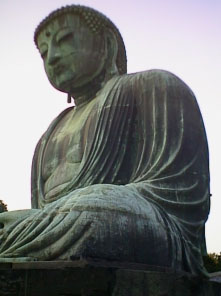
Gautama the Buddha in Meditative Pose
Unique among religions, Buddhism does not profess sin and punishment or penance, it abhors caste system and above all, this religion (along with Jainism) is not based on a belief in a Supreme Being or Soul.
“GAUTAMA THE BUDDHA” (Gautama the Enlightened one) 563-483 BC:
The Buddha was born prince of the Kingdom of the Sakyas near the border of present day Nepal and India but in ancient India on the full moon of the month of Vesaka (May). The place of birth was Lumbini, a park that his mother the queen passed on her way to her parents’ house in Devadaha. There, in a curtained enclosure, she gave birth to a boy; the place of his birth is marked by an “Ashoka Pillar” (erected in the 3rd century BC by Emperor Ashoka).
A dream his mother had the night before his birth foretold of the birth of a son who would either become a universal king or a Buddha. The sage Asita (also called Kala Devala) who was the teacher and religious advisor of the King Suddhodana, upon seeing the child and perceiving auspicious sights on his body, predicted that the boy will one day become a Buddha. Also, on the fifth day of his birth, during the naming ceremony, out of the 108 Brahmins (priests) present, seven of eight specialists in interpreting bodily marks prophesized that if the child remained at home he would become a universal monarch; however, if he left home he would become a Buddha. The child was named Siddhartha (in Pali, Siddhatta) which means “one whose aim is accomplished”. The ancient Buddhist literature has recorded another event when Siddhartha was a small boy. His father had left him with the nurses and gone to attend a local plowing festival. The nurses, distracted by the festivities, had left the boy alone for a short period. When the King returned, he found the boy seated under a ‘jambu’ tree in a ‘dhyana’ (meditation) pose, cross-legged and in a trance. The King knelt down in worship upon witnessing this awe-inspiring sight.
THE EARLY YEARS:
Seven days after his birth, Siddhartha’s mother Queen Mahamaya died and the child was brought up by her sister Mahaprajapati Gautami, as his father married her. In order to keep the prince happy and contended so that he will not leave home, the King lavished luxury on him. In the Buddha’s own words:
“Bhikkhus (monks), I was delicately nurtured, exceedingly delicately nurtured, delicately nurtured beyond measure. In my father’s residence lotus-ponds were made, one of blue lotuses, one of red and another of white lotuses, just for my sake…Of Kasi cloth was my turban made; of Kasi my jacket, my tunic and my cloak…I had three palaces: one for winter, one for summer and one for the rainy season. Bhikkhus, in the rainy season palace, during the four months of the rains, entertained only by female musicians, I did not come down from the palace.”
At the age of 16, he married his cousin, princess Yasodhara. Neither the marital bliss nor the luxury that was showered on Siddhartha completely satisfied his restless mind. Like other members of the aristocracy he had worldly weaknesses such as drinking alcohol and entertaining many concubines. Thus, when he was 29, for the first time in his life Siddhartha was exposed to human suffering. These “four signs” were as follows:
1) When he was outside the palace grounds he saw ‘an aged man, as bent as a roof gable, decrepit, leaning on a staff, tottering as he walked, afflicted and long past his prime.” Up to that time the prince has never seen an old man (so the story goes) and when questioned, his charioteer and companion told him that he was old and that all men were subject to old age, if they lived long enough.
2) Another day the prince saw “a sick man, suffering and very ill, fallen and weltering in his own excreta, being lifted up by some…” His charioteer again explained how people were subject to sicknesses.
3) Another day he saw a dead body and was told that everyone ended their lives in this manner eventually.
4) He saw a “shaven-headed man, a wander who has gone forth, wearing the yellow robes. The prince was impressed by the man’s peaceful and serene demeanor and this made his mind up in trying to wander out in the world to discover why the man displayed such serenity in the midst of misery.
THE RENUNCIATION:
Siddhartha decided to renounce his princely life and, after quietly bidding farewell to his wife who was asleep, he left the palace with his charioteer and companion, Channa. During that night they traveled on horse-back until by dawn they crossed the Anoma River. There Siddhartha gave all his ornaments to Channa, wore the cloth of ascetics and was thenceforth he was known as Gautama (Gotama in Pali). He traveled south to places renowned as centers of learning. He sought-out great teachers such as Alara Kalama and Uddaka Ramaputra. He quickly mastered all the mystical systems that they knew but was not satisfied. Finally, he arrived at a beautiful village in the Magadha County, where he met five ascetics. This village was called Senarigama, near Uruvela and they settled down to search for truth in earnest. What followed were severe austerities and extreme self-mortifications. After six years of such austerities Gautama was near death. The result of th e austerities was described by the Buddha himself as follows:
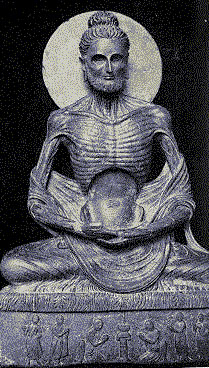
An Image of the Buddha during the period of severe austerities
“Because of so little nourishment, all my limbs became like some withered creepers with knotted joints; my buttocks like a buffalo’s hoof; my back-bone protruding like a string of balls; my ribs like rafters of a dilapidated shed; the pupils of my eyes appeared sunk deep in their sockets as water appears shining at the bottom of a deep well; my scalp became shriveled and shrunk by sun and wind,…the skin of my belly came to be cleaving to my back-bone; when I wanted to obey the calls of nature, I fell down on my face then and there; when I stroked my limbs with my hand, hairs rotted at the roots fell away from my body…”
At the end of this period he became convinced that such severe self-mortifications will not lead him any closer to the truth. He abandoned such measures; in disgust, his five companions left him. Gautama started to take nourishment and recovered in due course.
ENLIGHTENMENT: (Gautama to the Buddha)
“My mind was emancipated; …ignorance was dispelled, Science (knowledge) arose; darkness was dispelled, light arose.”
Gautama next turned to meditation, usually under a banyan tree and he would meditate, cross-legged for long periods. The day before his enlightenment, he meditated at the base of a pipal tree (this tree is now called bodhi tree). He was determined to stay in meditation until he attained enlightenment. He encountered a determined effort by Mara, the tempter and lord of the world of passion to distract him and defeat his attempts to reach enlightenment. However hard Mara tried to distract Gautama he could not accomplish his goal. He finally gave up his attempts altogether and disappeared.
After defeating Mara, Gautama continued the deep meditation. It is recorded that during the period between 6PM and 10PM (of the night of his enlightenment), he gained the knowledge of his former existences. During the next four hours he attained the “Superhuman divine eye”, the power to see the passing away and rebirth of beings. During the period between 2AM and 6AM with more intense meditation he learnt the Four Noble Truths. Thus, at the age of 35, Gautama attained enlightenment and became the Buddha; this was the night of the full moon day of the month of Vesakha (May) in or around the year 528 BC. The place of this enlightenment is now called Bodh Gaya (or Buddhgaya), in Northern India and is one of the foremost attractions to Buddhist pilgrims from all over the world. The other main attraction is Lumbini, his birthplace where the Ashoka’s pillar is still present.
THE “MIDDLE PATH”:
After he abandoned the severe austerities and self-mortifications, the Buddha adopted the “Middle Path”, between the extremes of self-indulgence and severe self-mortifications. This middle path will lead to vision, knowledge, calmness, awakening and ultimately to Nirvana.
The Buddha gave his first sermon called “Dhammacakkappavattana-Sutta (“Setting in Motion the Wheel of Truth”), to his first five disciples at Isipatana, which is now called Sarnath, near Varanasi or Benares in the banks of Ganga and where now stands the famous Ashoka Pillar. At this sermon Gautama the Buddha described four “noble truths”. The first noble truth was that human existence is full of conflicts, dissatisfaction, sorrow and suffering. The second noble truth is that all these stem from man’s selfish desire. The third noble truth is that one can attain liberation or emancipation from these sufferings and lead to Nirvana. The fourth noble truth is described below as the “Noble Eight-fold Path” which is the way to the liberation.
The middle path is also known as the “Noble Eightfold Path” and consists of:
1) Right view
2) Right thought
3) Right speech
4) Right action
5) Right mode of living
6) Right endeavor
7) Right mindfulness
8) Right concentration
“BHIKKHUS” (DISCIPLES) AND SANGHA (COMMUNITY):
The first disciples of the Buddha were the five mendicants who left him in disgust when he abandoned severe austerities and self-mortifications. However, this was accomplished with some difficulty and after some serious discussions. Once they became convinced of his sincerity and believed that he had indeed attained enlightenment, they started to address him as “Lord”. Within three months, Buddha had converted 60 people and their disciples. These included Buddha’s own father, step-mother, son and his former wife. To this first group of disciples he spoke the following words, in preparation for sending them out into the world to spread his message of peace, compassion, wisdom and truth:
“Bhikkhus, I am freed of all fetters, both divine and human. You, too, are freed from all fetters, both divine and human. Wander forth, Bhikkhus, for the good of the many, for the happiness of the many, out of compassion for the world…Let not two of you go by one road. Teach the Dhamma (Dharma in Sanskrit) which is good at the beginning, good in the middle and good at the end….”
Another famous sermon the Buddha gave was to three famous ascetics and their many disciples, all of whom converted. This sermon, called “The Fire Sermon” dealt with the fire of lust, the fire of hatred and the fire of delusion. This Sutra is famous in the West as it formed the basis of Section III of the poem The Waste Land by the Poet T.S. Eliot.
The Buddha’s and his movement’s popularity soared and he converted scores of Hindus of all classes. Many women were also admitted into the order. This popularity brought with it jealousy among hostile sects and individuals. Prominent among the latter was a cousin and an uneasy disciple called Devadatta. When his request for naming him as the successor of the Buddha was turned down, he became openly hostile. At least 3 attempts to assassinate the Buddha were made but all of them failed. He then tried to create a splinter group; after this also failed, he became seriously ill and died.
The Buddha died at the age of 80. By that time the movement he started had spread far and wide within India and was on the verge of spreading to neighboring countries; however, the Buddha himself never traveled outside of India. His last spoken words were: “Then, Bikkhus, I address you now: transient are all conditional things. Try to accomplish your aim with diligence.”
BIBLIOGRAPHY:
1) Encyclopaedia Britannica, 18th Ed. 1989 Vol. 115, pp 268-74
2) www.nationmaster.com/encyclopedia/Buddhist
3) www.san.beck.org/EC9-Buddha.html
4) www.buddhist-temples.com/gautam-buddha.html
5) www.buddhist-temples.com/buddhist-religion.html
7) www.buddhanet.net/e-learning/buddhistworld/buddha.htm
2) ESSENTIALS OF THE TEACHINGS OF THE BUDDHA
The Buddhist Philosophy can be comprehended by considering the following segments:
1) SUFFERING AND ITS CAUSES:
The cornerstone of the Buddha’s teachings is that of human suffering. He stated that the existence itself is painful; the same conditions that make an individual also give rise to suffering. Individuality (a basic tenet of the Western psyche and which can be based on the notion of “I” and “mine”) implies limitation; limitation gives rise to desire; desire brings suffering.
2) IMPERMANENCE:
This suffering is caused by the fact that what is desired is often transitory, changing and perishing. It is this impermanence of the object of one’s desire that leads to disappointment and sorrow. The Buddha’s teachings are directed to removing the “ignorance” and thus guides to freedom from this suffering.
3) NONSELF (NONEGO):
The Buddha described the human existence as an aggregate of five constituents as follows:
a) Corporeality or physical form (“rupa”),
b) Feelings or sensations (“vedana”),
c) Ideations (“samjna”),
d) Mental formations or dispositions (“samskara”),
e) Consciousness (“vijnana”).
He argued that as the human existence requires all five of the above constituents and each of them in isolation will not form the self or soul without the help of the others, the Buddha termed this state as “nonself” or “nonego”.
4) KARMA:
Despite this notion of “nonself” or “nonego”, the Buddha taught that one carried one’s Karman from one life to the next. For example, good conduct is believed to bring pleasant and desirable results and bad conduct to lead to an evil result and repeated evil actions. This formed the basis for moral conduct to improve one’s lot.
However, the belief in “nonself “(i.e. absence of belief in a soul), while believing in repeated births and improving or worsening Karman have been attacked by non-Buddhist Philosophers. They question how a rebirth can take place without a permanent subject to be reborn. This argument remains unsettled.
5) FOUR NOBLE TRUTHS:
The Buddha formulated his “Four Noble Truths” to pave the way to removing the human misery. He described these tenets as follows:
a) The truth of misery (“dukkha”),
b) The truth that the misery originates from the craving for pleasure,
c) The truth that this misery can be eliminated,
d) The truth that this elimination results from a methodical way that must be followed. This
depends on an understanding of the evolution of a person’s psychosocial development.
6) THE LAW OF DEPENDENT ORIGINATION:
This law explains how every condition is interdependent on another prior condition. He stated that the original condition is ignorance (avijja); next is the cooperating karmic agents (i.e. mental qualities, dispositions and habits); then consciousness and then “name and form” (the naming and materiality of things). The next in line are the five sense organs and the mind; these in turn “condition” contact. This contact leads to the psyche, mental or emotional responses to sense objects (vedana). These objects lead to craving, the grasping for and attachment to the objects. This attachment determines “bhave” (or coming into existence) and hence “jati” (birth). The birth ultimately leads to old age, misery, death and so on….The Buddha includes the present day ignorance to the cooperating karmic agents from inheritance from the past. Solitary meditation by the Buddhist aspirant is an essential and fundamental means to understand this dependent origination. Likewise, present day karmic charge is believed to project into the future. Thus the dependent origination takes men into space and time, with the consequence of birth and death cycles.
7) EIGHTFOLD PATH:
The Buddha contemplated this “Eightfold Path” as the means to escape the above cyclical events. Ethical conduct has a major role in this purification process. With sincerity, reinforced by continued meditation, the Buddhist aspires to be liberated. The essentials of the “Noble Eightfold Path” are:
i) the right mode of seeing things (right view),
ii) right thinking,
iii) right speech,
iv) right action,
v) right mode of living,
vi) right effort in every mode of being,
vii) right mindfulness,
viii) right meditation or concentration.
8) NIRVANA:
Every Buddhist aspires to be rid of the delusion of ego, free oneself from the fetters of this world, thus overcome the repeated rounds of rebirths. This state of “Enlightenment” is a goal, not a “heavenly world or paradise”. To put it another way, the Buddhists aim to extinguish the fire that accompanies living; the fire of illusion, passion and craving. They search for not just the cessation of this fire but for the eternal, the immortal. Nirvana is thus explained as an ideal state, as ultimate bliss.
The ultimate explanation is offered by the Buddha himself in his inimitable language:
“There is an unborn, an unoriginated, an unmade, an uncompounded; were there not, there would be no escape from the world of the born, the originated, the made, the compounded.”
NB: When words in italics appear in the text, within parentheses, they are Sanskrit words accompanying the English translations.
BIBLIOGRAPHY:
1) Encyclopedia Britannica, 18th ed. 1989, Vol. 15, pp 274-76
2) www.san.beck.org/EC9-Buddha.html
3) www.nationmaster.com/encylcopedia/Buddhist
3) BUDDHISM - A WORLD RELIGION
THERAVEDA BUDDHISM
Gautama the Buddha did not claim to be divine or even as a prophet. He did not even invoke an omnipotent “God” or require his followers to worship him. Instead, he encouraged them to follow the “Dharma” that he preached. At the time of his death the Buddha did not name a successor and thus the democratic principles followed by the “Sangha” (community) guided the organizational hierarchy of the emerging religion. Nevertheless, in due course of time his followers did begin worshipping the Buddha himself, no doubt due to the human need for devotion to a savior-deity. There was also born the “Three Refuges” that all branches of Buddhism follow:
"Buddham-Saranam Gatchami (Vow to take refuge in the Buddha)”
“Dharmam-Saranam Gatchami (Vow to take refuge in the Dharma)”
“Sangham-Saranam Gatchami (Vow to take refuge in the Sangha)”
PANCHA SILA OR DASA SILA: (The five and ten precepts)
The Pancha Sila are meant to guide the moral obligations of laymen. These are “prohibition of killing, stealing, engaging in sexual misconduct, lying and drinking intoxicating liquor”. The five additional precepts (which the monks are required to follow) are “not to eat during prohibited hours, not to take part in festivals and amusements, not to use garlands, perfume or ointments, not to use a bed (or chair) that is too large or luxurious and not to use money (for oneself). This distinction between the lay followers and monks and members of the Sangha and non-Buddhists is in contrast to the Buddhists not recognizing caste, social class or ethnic origin.
THREE BUDDHIST COUNCILS:
Soon after the Buddha’s death a ‘council’ was called at Rajagraha with 500 “Arhats” (monks) in attendance. There they developed a “vinaya” (monastic discipline) under the leadership of the monk Upali and the “dhammas” (the sutras) under the leadership of the monk Ananda. A second council was called at Vaisali; this one was contentious and resulted in an apparent split between strict followers of the Buddha’s teachings and others who wanted to relax the rules. The third council was called by King Ashoka at Pataliputra (Patna) in 250 BC. At this council the Tipitaka (Buddhist Canon) was completed. Following this Ashoka sent missionaries to all over India and abroad; he also erected “Ashoka Pillars” with inscriptions on the pillars outlining the pursuit of Dharma and just living according to the Buddhist doctrines, all across India. However, a serious split arose between the Buddhist communities, involving the “Sarvastivadins” and the “Theravadins” over the former block’s belief of the reality of the past and future states of consciousness and which the latter condemned. The ‘Sarvastivadins’ (those who believed that ‘everything’ exists i.e. Space, past, present, future and Nirvana) were the fore runners of ‘Mahayana’ faction of Buddhism; whereas the ‘Sthaviravadans’ or ‘Sautrantikas’ (who favored the ‘Sutras’ over ‘abhidharma’ or higher dharma) evolved into the “Hinayana” faction. Over the centuries several smaller factions of Buddhists have evolved but our discussion will focus on these two predominant factions. The Theravada (Sthaviravada) spread from India to Sri Lanka (Ceylon) and the South East Asian countries. They were called “Hinayanans” by the more numerous Sarvastivad followers (“Mahayanans”).
THERAVADA (STHAVIRAVADA):
Theravadians follow the original Pali Canon of ancient Indian Buddhism. This is the school that Emperor Ashoka spread to Sri Lanka (Ceylon). From there this form of Buddhism spread to the South East Asian countries such as Myanmar (Burma), Cambodia, Laos and Thailand.
In this form of Buddhism, the followers are not concerned with metaphysical problems but with day to day psychosomatic interrelationship and cultivating ways of arriving at the state of an “Arahant” (“worthy one”). The ultimate aim is to pass from the temporal to the atemporal phase and overcoming the cycles of rebirths, i.e. a path to enlightenment. Seven factors of enlightenment and fours subsidiaries are recommended:
SEVEN FACTORS OF ENLIGHTENMENT:
1) Clear memory,
2) Exact investigation of the nature of things,
3) Energy,
4) Sympathy,
5) Tranquility,
6) Impartiality and
7) A disposition for concentration.
FOUR SUBSIDIARIES:
1) Love for all living creatures,
2) Compassion,
3) Delight in that which is good or well done and
4) Impartiality.
STAGES OF ARAHANTSHIP:
Those who believe in the teachings of the Buddha pass through these four stages:
1) One who has joined the stream and begun the process towards release from rebirth,
2) The next stage is where one only returns once,
3) The third stage is that of one who does not return again.
4) The stage of the arahant; one who has gained freedom from death. He is free from all bonds,
desire for existence, ambition and ignorance.
THE BUDDHA:
The state of the Buddha, the perfectly Enlightened one is “Nibbana” (Sanskrit Nirvana) from which one does not return. There are two kinds of Nirvana. One is achieved by the Buddha while he is still alive but after expending all karma. In the other, the Buddha dies and enter the Nirvana without remains.
THE PALI CANONS: (Early Buddhist Sacred Literature)
This is the Pali “Tipitaka” or “The Three Collections”: There is no parallel collection in Sanskrit. The three “Baskets” containing the 32 texts of Pali Canons are:
a) Vinaya Pitaka (“Basket of Discipline”),
b) Sutta Pitaka (“Basket of Discourse”) and
c) Abhidhamma Pitaka (“Basket of Scholasticism”).
A) VINAYA PITAKA:
This further divided into 3 divisions:
i) Sutta-Vibhanga (“Division of Rules”): These describe the obligatory rules and consists of
the Bhikku-patimokkha (“Rules for Monks”) and Bhikkuni-patimokkha (“Rules for Nuns”).
ii) Khandhakas (“Sections”): These have two parts: the Mahavagga (“Great Grouping) and the Cullavalgga (“Small Grouping”). These are rules of ordination and deal with “observance” days, descriptions of rainy-season retreats, clothing, food and medicine, judicial rules etc.
B SUTTA PITAKA:
These contain the discourses of the Buddha and are contained in five nikayas (“collections”). These start by the affirmation “Thus I have heard” and then mention the place and the occasion of the discourse. Although these may not represent the exact words of the Buddha, they do provide an insight into his didactic technique and show the richness and beauty of the illustrative similes.
i) Digha Nikaya (“Collection of Long Discourses”): This collection contains 34 Suttas and are divided into 3 books. These contain many doctrinal and philosophical ideas and ascetic practices and are peppered with similes and examples from every day life of ordinary people.
ii) Majjhima Nikaya (“Collection of Medium-Length Discourses”): This Nikaya has 152 Suttas (222 in the Chinese version). Like the Digha Nikaya, this collection is written in great poetic style and illustrated with similes.
iii) Samyutta Nikaya (“Collection of Kindred Discourses”): This has 2941 Suttas, in 59 divisions and grouped in five vaggas (parts). The first vagga has stanzas in the form of questions and answers. The second vagga deals with the principle of dependent origination. The third vagga deals with the doctrine of anatman (“nonself”). Fourth vagga deals with the transitoriness of the elements constituting reality. The fifth vagga consists of general discursion of the basic principles of Buddhist philosophy and religion.
iv) Anguttara Nikaya (“Collection of Item-More Discourses”): In this Nikaya there are 2308 small suttas organized into 11 groups. The discussions range from the training for good conduct, concentration and insight; eight worldly concerns of gain, loss, fame, blame, rebuke, praise, pleasure and pain. Here too similes enliven the discussion of such serious topics.
v) Khuddaka Nikaya (“Collection of Small Texts”): There are a total of 15 titles that range from a book for use by primary trainees, “Verses on the Dhamma”, “Utterances” (80 in all of the Buddha, “Hymns of the senior Nuns” and so on and so forth. The most important is “Suttanipata” (Collection of Suttas) and written in prose and in verses of considerable poetic quality.
C) ABHIDHAMMA PITAKA:
Only the Pali version of Abhidhamma Pitaka will be discussed here as that is the one that is followed by the Theravada school. This can be broken down to seven works:
1) Dhammasangani (“Summary of Dharma”) deals with the constituents of reality,
2) Vibhanga (“Division”): an elaboration of those constituents from various points of view,
3) Dhatukatha (“Discussion of Elements”): a classification of the elements of reality according to
various levels of organization.
4) Puggalapannatti (“Designation of Person”): Psychological classification of people according
to their intellectual acumen and spiritual attainment.
5) Kathavattu (“Points of Controversy”): This deals with doctrinal differences between various
denominations of Buddhism; it does deal with the movement that later became known as
Mahayana.
6) Yamaka (“Pairs”): Basic sets of categories arranged in pairs of questions.
7) Patthana (“Activations”): Discuss 24 kinds of causal relations.
A discussion of Pali literature in Theravada Buddhism cannot be considered complete without mentioning four great authors. These are 1) Nagasena: (~ 150 BC), who is credited with debates with the Greco-Bactrian ruler Menander and with the great literary work Milinda-panha.
2) Buddhagosa (AD 400): who had written the whole compendium of “Visuddhi-Magga (“Way to purity”) which deals with the whole Tipitaka. He also wrote commentaries on the vinaya, all principal nikayas and on the seven books of Abhiddhamma Pitaka.
3) Buddhadatta (a contemporary of Buddhagosa): He wrote a summary of the older commentaries on Abhiddhamma Pitaka. He reduced Buddhagosa’s five elements of metaphysical ultimates i.e. Form, feeling, sensations, motivations and perceptions to only four: mind, mental events, forms and Nibbana. 4) Dhammapala wrote commentaries on all the work not treated by Buddhagosa.
THE GREEK AND PERSIAN INVASIONS:
Included under this heading are states that were established before the Mauryan Empire (as the time-line would require) and only a short description will be given. The states with ties to Persia or Greece that came into being after the fall of the Maurya Empire will be dealt with later.
In 327 BC the Macedonian ruler Alexander entered Gandhara (in the Northwestern part of India, across the Indus River’s tributaries). His troops defeated the army of King Porus. However, his campaign to continue eastward failed as his army refused to continue fighting. Historians believe this to be at least in part to the fact that the army they confronted (the Nandas) was huge and seemingly invincible. Alexander’s plans to conquer the rest of India were thus thwarted and his campaign did not leave much impression on India, its history or culture. This was despite the fact that he did establish a number of Greek settlements in India. The Persian Empire under Darius extended to the Gandhara but no great campaigns were carried out by the Persians into India before or after the time of Darius.
THE MAURYAN EMPIRE (325 TO 185 BC):
The Mauryas occupy an important place in Indian History for three reasons. First, because it was the first true home-spun empire. Second, at its peak, its boundaries included parts of present day Afghanistan, the whole of northwestern and much of the eastern India as well as the Deccan plateau. Only the Deep South was not part of the empire and only the Moguls during their heyday and of course, the British controlled more land under one administration. (Please refer to the map). Third and perhaps most poignantly, this dynasty produced a ruler who was ruthless as a warrior but attained greatness once he began ruling through winning hearts rather than battles. This was the 3d Maurya ruler, the Emperor Ashoka "the Great"
The Maurya dynasty was founded by Chandragupta Maurya after he overthrew the Nanda kingdom of Magadha. His next major campaign and one that was crucial in the foundation of the empire was a war with the Greek General, Seleucus 1 Nicator in the Trans-Indus region in the year 305 BC. Seleucus was one of Alexander’s generals who founded the Seleucid dynasty in Iran. This war ended in a treaty in which Seleucus gave up the Tran-Indus provinces to Chandragupta and in return received 500 elephants. Both Chandragupta and Seleucus had a lengthy and fruitful alliance and many of the written observations of the Maurya kingdom came from some of Seleucus’ envoys. One such envoy, Megasthenes wrote a book entitled “Indica”
In addition to this work, a major contribution came from Chandragupta’s Prime Minister Chanakya (or Kautilya); this was called “Artha-Shastra”. It dealt with both political and economic matters of importance. For many centuries, additions were continually made to this influential compilation.
The second monarch of the Maurya dynasty, Bindisara asended the throne when Chandragupta abdicated to follow the strict teachings of Mahavira and Jainism. His rule was not noted for any significant achievements but he did extend the empire southward, up to the present day Karnataka.
ASHOKA THE GREAT: (272-235 BC):
In Ashoka we find the pinnacle of the Mauryan Dynasty in terms of both its physical reach and its influence and stature in world states. The fateful event that stopped Ashoka’s campaign of empire building by war and launched his conquest of the heart of both his subjects and subjects of foreign lands occurred in 260 BC. In Kalinga, a southeast kingdom, a fierce battle was waged. While he was victorious in the battle, the slaughter of 100,000 soldiers and injury of a further 150,000 shocked Ashoka. He gave up military campaign and decided to pursue the practice of Dharma according to the teachings of the Buddha. He sent emissaries to various neighboring and distant countries to spread this message. There is ample written evidence that he kept in touch with the contemporary Greek rulers such as Antiochus II Theos of Syria, Antigonus II Gonatas of Macedonia, Magas of Cyrene as well as the Egyptian monarch Ptolemy II Philadelphus. Through the erection of edicts all across India and the southern neighbor Sinhala (Sri Lanka) he was instrumental in spreading Buddhism all across the subcontinent.
The Mauryan Government, Economy and Society:
This empire was a centralized bureaucracy with the Emperor at the helm. Through his ministers, his extensive travels throughout his empire and through the edicts, Ashoka kept in touch with his subjects. The main source of income was the land revenues and to a lesser extent from trade. Both the land and the produce of the land were taxed. The society was structured around endogamous castes (philosophers (which included the priests and monks and religious teachers), soldiers, herdsmen, artisans, magistrates and councilors) and the professions were considered hereditary.
The empire was divided into four provinces, each ruled by a prince. These provinces were then divided into smaller denominations, which were headed by local officers. The most powerful local officer in a city was the City Superintendent (“nagaraka”).
The Ashoka Pillars:
During this golden age of Indian civilization, Ashoka is remembered for many an innovation, which would make any contemporary Indian ruler proud. Across his empire Ashoka had constructed wide roads lined on either side by shade trees (avenues) and for the tired and thirsty traveler wells and stored water were provided at stations. He constructed hospitals for caring for the sick (by any standard, a very enlightened measure that few other ancient monarchs in world history can boast) and warned against wanton destruction of forests as they would spell ecological disaster.
All the above accomplishments pale in significance to the role he played in spreading Buddhism throughout India and the rest of Asia. And in this process, a prominent role was played by his famous edicts inscribed on the pillars that he erected all across India. These pillars are now known as Ashoka Pillars, they were made of polished sandstones and were erected on bases which are called Stupas. The most famous of these is the one at Sarnath, sporting the heads of four lions on top. These images have been immortalized by modern India as the National Emblem (see our link at the beginning of “Historical India”). Also, immortalized was the “Wheel of Dharma” found on the base holding the animals as it is now in the middle of the Indian flag. The pillars were virtual emissaries from Ashoka as they carried inscriptions in “Prakrit” form of Sanskrit on the practice of Dharma (variously interpreted as one’s duty, universal law, the social order or righteousness). Very few of these pillars still survive but each sported the image of at least one animal’s head on top; besides lions, elephants and bulls were other examples.
DECLINE AND FALL OF MAURYA EMPIRE:
THE MUGHALS
History accords the Mughals a special place, both as a memorable dynasty that left remarkable edifices but also as one that ruled over much of India. Only the British managed to control more land and even Ashoka the Great did not extend his empire into south India. A notable contrast with the British (and the other European colonial powers) however, is the fact that the Mughals also absorbed Indian traditions and especially Akbar also tried to synthesize an amalgam of Indian and Mughal life styles.
FOUNDING OF THE EMPIRE:
BABUR: (AD 1526-30)
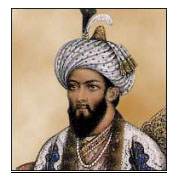
The founder of the Mughal Empire, Babur (Zahir-ud-din Muhammad) was a descendent of both Timur on the paternal side and Gengiz Khan on the maternal side. He was the ruler of Kabul while Sikandar Lodi built the new city of Agra. Babur had attempted to invade India five times but only succeeded in 1526, at the Battle of Paniput.There he defeated the Sultan Ibrahim Lodi and set up the new empire.He sent his son Humayun to Agra, the capital of Sultan Lodi to capture the palaces and treasures of the Sultan.Within two years of ascending the throne Babur consolidated his rule by first defeating a confederacy of Rajput kings led by Rana Sanga and in 1529 by defeating the forces of both Bihar and Bengal on the bank of Ghagra. He extended the empire from Kabul to Bihar and the Himalayas to the River Ganga. In 1530 he died and was buried in Kabul.
BABUR’S INDIA
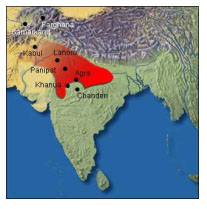
HUMAYUN: (AD 1530-1556)
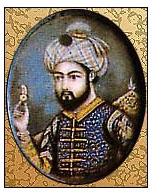
Nasir-ud-din Muhammad Humayun (AD 1508-1556), the eldest son of Babur ascended the throne in 1530 and ruled until 1540. He met defeat at the hands of the Afghan ruler Sher Khan Sur in 1540, at Chausa, between Varanasi and Patna. His army of 40,000 was defeated by a smaller army of 15,000 of Sher Khan Sur Humayun went into exile. He was given refugee in Persia by the Shah of Iran, Shah Tamasp. However, 15 years later he returned and regained the monarchy. His short rule of only 10 years was punctuated by conquests but no artistic or literary accomplishments. That privilege would fall in the hands of his descendants.

HUMAYUN'S TOMB (DELHI)
AKBAR THE GREAT: (AD 1556- 1605)

Akbar, the third Mughal Emperor was only 13 when he ascended the throne upon the untimely death of his father, Humayun. He ruled under the able guidance of Bairam Khan, a prominent nobleman and won a decisive battle against the Afghans. This, the second “Battle of Paniput” assured the continuation of the Mughal Empire. In 1562 Akbar took charge as the Emperor after he removed Bairam Khan from power.
For the next 30 or so years he concentrated on expanding the Empire, which meant he was constantly at war. However, when possible he used conciliation and reward for loyalty to gain control of Kingdoms and their land. He also followed an active program of involvement and amalgamation of the various kingdoms, especially of the warring Rajputs. Unlike most muslim rulers he encouraged marriage between Hindus and Muslims. His favorite wife (first of 33 wives), was a Hindu Princess from Rajput. By the end of his campaign Akbar had extended his empire all across North India and Afghanistan as well as the Deccan in the south.
During the early part of his rule Akbar used Nagarchain, a village seven miles to the south of Agra. At the same time he had also revamped Agra by building over 500 masonry buildings. However, in 1571 he moved his capital to the newly built city of Fatehpur Sikri. A crowded metropolis during Akbar’s reign, this city fell victim to lack of planning and was abandoned when water shortage became acute.
Akbar is credited with building the Empire into one of the richest in World history and perhaps the wealthiest of the time. Besides his gift of conquests, he was a great administrator and with the conciliatory policies towards the nonmuslims, he gained the loyalty of vast majority of his subjects. The liberal bend in his character is amply evidenced by his marrying two Hindu Princesses and then allowing them to practice Hindu religious ceremonies in the Harem.
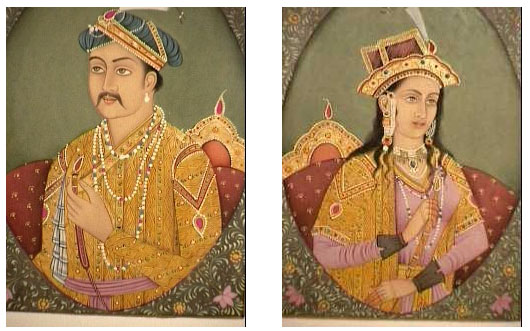
Akbar and his Hindu wife Jodhbai
Akbar’s greatest gift and genius was primarily military; thus he built an empire that would engulf almost the whole of India and Afghanistan. Most of the population of India (estimated at 140 millions) were his subjects; compared to this, the whole population of Europe was only 40 Million and that of England only 5 Million. His reforms in administration and taxation were also in part responsible for the sustenance of this vast empire. The abolition of the unpopular taxation of all but the wealthiest of the non-Muslims; his conciliatory gestures to Hindu rulers and even appointing them in senior posts in his administration further improved his credibility among the masses. Finally, his patronage of literature, the arts and music despite his own illiteracy and the balanced treatment of all religions ushered in a period of prosperity rarely matched in Indian history. While Fatehpur Sikri was abandoned as the capital city, its stunning architecture remains a fitting monument to this golden age of medieval India. The influence of Akbar and his successors spanned not only architecture and garden design but the Indian music and cuisine have been transformed forever. Is it any wonder why Akbar is celebrated as “The Great”, a distinction he shares with another Indian Emperor, Ashoka?
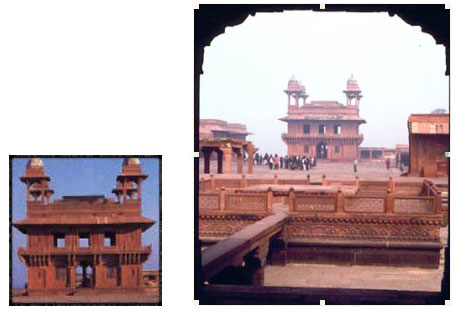
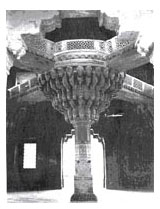
THREE VIEWS FROM FATEH PUR SIKRI
JAHANGIR: (AD 1569-1627)
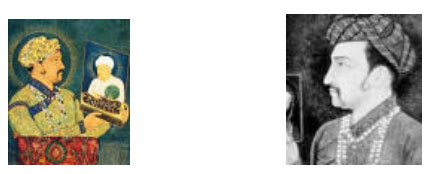
Prince Salim was one of three sons of Akbar, of a Hindu Princess from Amber; the other two sons Prince Murad and Daniyal died early of excessive drinking. During Akbar’s long rule Prince Salim rebelled and exhibited impatience and a struggle took place with his father, the Emperor. Matters were also muddied by the fact that he (Prince Salim) had an affair with a court dancer (of “Anarkali” fame and the basis of the Hindi epic movie “Mughal-E-Azham”). When Akbar died in 1605, Prince Salim ascended the throne and proclaimed himself “The World Conqueror” or Jahangir. The battles for succession in this monarchy started when Salim’s own son Prince Khusrau also vied for the throne but Jahangir managed to prevail.
Unlike his father, Jahangir did not have much success in battles, especially in the Northwest although in the Deccan, his armies did defeat Malik Ambar. The task of dealing with Malik Ambar was left in the hands of his third and favorite son, Prince Khurram (later Emperor Shah Jahan). As a result of the able administration of Akbar the Mughal treasury had unlimited funds and both he and his son Shah Jahan could afford to spend large sums in constructing monuments and gardens. Much of the administration of the empire was left in the able hands of his wife Nur Jahan and her father Itimad-ud-daula and her brother Asaf Khan. Jahangir spent much of his time relaxing in the famous gardens he built in Kashmir. Unlike his predecessor, Akbar, or his successor Shah Jahan, Jahangir left no lasting relics.
NUR JEHAN
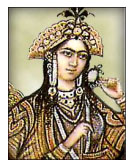
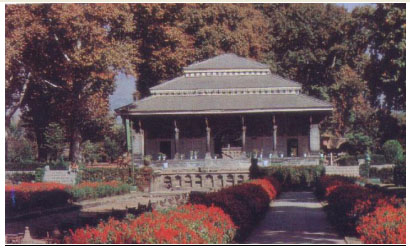
SHALIMAR GARDENS
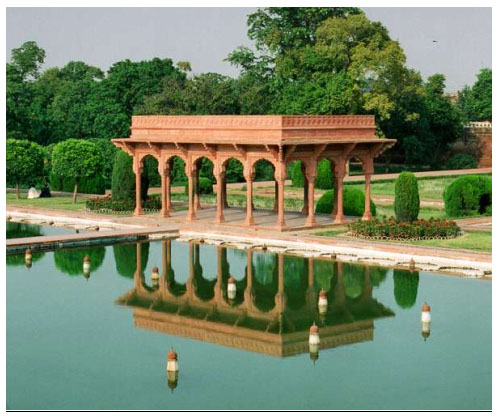
SHALIMAR GARDENS
SHAH JAHAN: (AD 1592-1666)
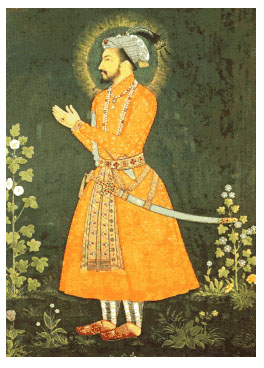
Like his father Jahangir, Prince Khurram was also born of a Hindu princess (Rajput princess Manmati). But unlike his father, there was tumultuous battle for succession between Prince Khurram and his brothers and his brother-in-law (Nur Jahan’s son-in-law) prince Shariyar. On ascending the throne Prince Khurram assumed the name of Shah Jahan (“King of the World”). Having inherited great wealth and thanks to the able administration of his grand father Akbar and is aesthetic qualities, Shah Jahan set out to build great monuments.
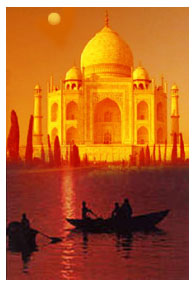
Thus he built the black marble pavilion at the Shalimar gardens in Srinagar in Kashmir, white marble palace in Agra and a large city which he called Shahjanabad in Lahore. However, his greatest achievement was building the world famous Taj Mahal. It was built as a lasting monument to his love for his favorite wife and constant companion, Mumtaz Mahal (Princess Arjuman Banu who was the niece of Nur Jehan). He was devastated when Mumtaz Mahal died prematurely while giving birth to their fourteenth child. At her deathbed she asked Shah Jahan to build the most beautiful mausoleum. Once he recovered from the shock of losing her, the Emperor set out to build this lavish edifice. Please refer to the accompanying links to Taj Mahal for details and more pictures. Shah Jahan also built the Juma Masjid and renovated forts in Delhi and Agra. After he was imprisoned by his third son Aurangzeb as a part of his battle for succession, Shah Jahan was kept prisoner in the Agra fort for the last eight years of his life. From there he could gaze at the Taj Mahal. In 1666, at the age of 74, Shah Jahan died and was laid to rest next to his wife.
During his reign Shah Jahan did manage to extend the empire to the Deccan. However, his conquests to Afghanistan were quelled by the Persians in Kandahar. Thus the lasting legacy of Shah Jahan was architectural and not the size of the empire or any philosophical or literary achievements, unlike his grand father Akbar.
AURANGZEB: (AD 1618-1707)
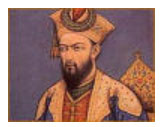
Aurangzeb was acting as Governor of Deccan at the time the power struggle for succession to the throne of the Mughal Empire began. His father, Emperor Shah Jahan preferred the first son, Prince Dara Shikoh. The latter had shown great promise to carry on the enlightened path of his great grandfather, the great Akbar. His potential was amply revealed by him translating the Hindu Upanishads into the Persian language. However, he would turn out to be less able in the battle for succession and Aurngzeb marched from the Deccan, kill all his challengers and ascend the throne.
After dispensing of all opposition, Aurangzeb imprisoned his father whom he kept for eight years under house arrest in the Agra Fort. There, Shah Jahan took solace in the fact that he could gaze across the Yamuna River, at the spectacular monument he built for his beloved wife Mumtaz Mahal. Aurangzeb systematically dismantled every gain that his predecessors did in ruling a predominantly Hindu India with diplomacy and conciliation. Thus, during his reign the vastly unpopular taxation system whereby non-Muslims were taxed (“jizya”) was reinstated. Hindu temples and traditions were systematically destroyed with the hope of converting the whole of India into an Islamic state. Where the holiest of Hindu temples were desecrated and destroyed, Aurnagzeb built Muslim mosques. His long reign was bereft of any lasting monuments or architectural achievements that were the hallmarks of the Mughal rulers from Akbar’s time onwards.
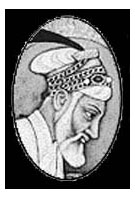
For over 27 years and until his death Aurangzeb was bogged down in battles in the Deccan. Much effort went into subduing the Marathas who were under the cunning leadership of Shivaji. With able administration and with shrewd military conquests Aurgangzeb extended the empire into Tibet and Assam. But as history would record, through his bigoted actions Aurangzeb presided over the moral demise of this once great empire. In 1707 at the age of 90 he died and another bitter struggle for succession ensued. The victor, Prince Muazzar assumed the name of Bahadur Shah and rule over the dwindling empire. The last Mughal king was Bahadur Shah Zanfar II who was dethroned in 1858 and the British era was in full swing.
USEFUL LINKS:
1) www.indianest.com/history/009.htm
2) www.indhistory.com/akbar.html